Fishing for crucian carp with a float rod in spring
After a long winter, fishing for crucian carp with a float rod in the spring is the first joy for anglers who are not involved in ice fishing. Unlike other fish species, crucian carp, in most reservoirs, having slept all winter, comes out of hibernation first and begins to actively feed, delighting fishing lovers with good catches. Spring fishing for this fish, despite its activity, is not as easy as it seems at first glance - without knowing the place and time, good sensitive tackle, and a set of baits, catching a silver handsome even at this time can become very difficult and not at all exciting.
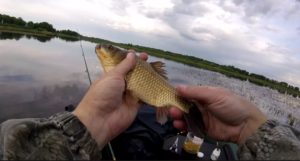
Content
- 1 Distinctive features when fishing for crucian carp in the spring on a float
- 2 Where and when to catch crucian carp in the spring with a float rod
- 3 Features of catching crucian carp on a float, depending on the month
- 4 Fishing rod rigging for crucian carp in spring
- 5 The main types of bait for crucian carp in spring
- 6 The technique of catching crucian carp with a float rod in spring
- 7 The specifics of fishing for crucian carp from the shore, boats and at night on a float
Distinctive features when fishing for crucian carp in the spring on a float
Unlike the hot summer, fishing for crucian carp in the spring with a float rod has a number of very important features that any angler must take into account at this time of the year:
- Shallow fishing depth - unlike summer, when crucian carp tries to hide from the heat in deeper places with cool water, in spring it spends most of the day on coastal shoals, where the water is well warmed up and there is plenty of food.
- Using thin, unobtrusive rigs - spring crucian carp is not as lively as in summer, therefore, to catch it, you need a fairly thin and sensitive rig.
- Caution and noiselessness - in spring, the water is still very transparent, and therefore, during fishing, the angler needs to stand up as little as possible and move along the shore near the tackle so as not to frighten the fish.
- Application of baits - trying to accumulate a sufficient supply of nutrients for spawning in the spring, the fish prefers more nutritious baits.
- Catching in the afternoon - unlike summer in spring, this fish is caught from 7-8 o'clock in the morning until the evening.
Where and when to catch crucian carp in the spring with a float rod
Crucian carp is caught in the spring on a float mainly in small reservoirs, where, due to their small volume, the water reaches a temperature of + 7 + 10 degrees earlier than in large lakes, reservoirs and river creeks.

The main places for catching crucian carp with a float rod at this time are:
- Shallow areas of ponds and lakes with a depth of no more than 1 meter.
- Floodplain lakes with shallow depth and abundant thickets of last year's reeds and reeds.
- Backwaters and bays of small rivers with a slow current.
- Discharge channels of warm water from thermal power plants.
- Reclamation ditches.
- Swamps and "frogs".
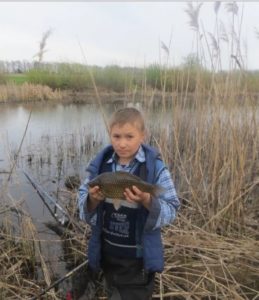
Crucian carp is most active in mid-spring after 7-8 am and until the evening. At the end of May, with the onset of warm days and nights, the activity shifts to the early morning and late evening hours.
Carp bites well in late spring also at night.
Like all fish, crucian carp is influenced by such weather factors as atmospheric pressure, wind, precipitation. So, in the spring, fishermen noticed the following regularities of the influence of meteorological conditions on fish activity:
- The most active biting is in the middle of spring during warm sunny days with constant pressure and light warm wind.
- In late spring, when hot days come, this fish is more active on cloudy warm days with light rains and weak winds.
- A sharp cold snap with heavy rains and a gusty cold north wind negatively affects the bite.
Features of catching crucian carp on a float, depending on the month
Each of the three spring months has its own characteristics in fishing for crucian carp with a float rod.
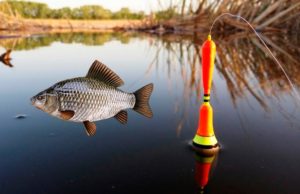
March
During the harsh winter in March, most of the crucian carp reservoirs are still covered with a thick, although not so strong, ice shell. But under the ice, together with the melt water, the life-giving oxygen dissolved in it begins to penetrate. This activates the behavior of the fish, forcing it to move around the water area in search of food. In this case, crucian carp is caught in March with a winter analogue of a summer float rod.
If the end of winter turned out to be warm, and some small bodies of water were free of ice by the beginning of mid-March, you can try to fish in them in deep places using long flywheels or Bolognese float rods.
The main bait for catching carp in March for both winter and summer gear is bloodworms.
Video: fishing for crucian carp on a float in early spring in March
April
From mid to late April, as the water warms up, the crucian carp becomes very active. They catch him at this time at a slight distance from the coast using the thinnest summer rigs. Bait is used in small quantities, adding a few drops of attractants.
As bait when fishing for crucian carp in April, I use bloodworms, large dung worms, maggots.
Video: fishing for crucian carp in April with a fishing rod with a float
May
Fishing for crucian carp in May with a float rod due to the upcoming spawning may last, depending on weather conditions, both until the middle and until the end of the month. Before spawning, crucians are caught in the same places as in April. As aquatic vegetation appears, along with bait, the fish begins to show interest in baits of plant origin - semolina, dough, barley.
Fish spawn when the water warms up to a temperature of at least +16 0C in small coastal areas with thickets of fresh and last year aquatic vegetation. During the spawning period, the fish does not feed.
With abnormally warm or hot May at the end of the month, crucian carp begins to be caught not only in the morning and evening hours, but also at night.
Video: large crucian carp on a float in May
Fishing rod rigging for crucian carp in spring
For fishing for crucian carp in the spring with a float rod, equipment plays a very important role along with the choice of place, time and bait.
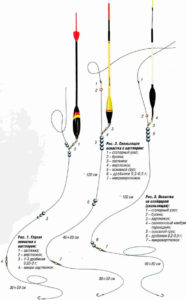
Rod
For the most common and accessible to most anglers, float fishing from the shore is used fly and Bolognese rods. The choice depends on the casting distance:
- In places where the casting distance is no more than 10 meters, and the depth at the fishing point is no more than 1.0 meters, lightweight carbon fiber fly rods 4-5 meters long are needed
- For casts over 10 meters and a depth of up to 1.5 meters, 5-7 meter carbon fiber Bolognese rods are used
Coil
When using Bologna rods, they are equipped with a simple reel or small spinning reel.
Fishing line
For spring fishing, use a thin monofilament line with a section of 0.16-0.18 mm.
Float
The float is selected in an elongated spindle shape with a long antenna painted in bright colors. The keel and lower part of the body of the float should be of an inconspicuous dull color. The greatest sensitivity when fishing for crucian carp in the spring are floats with a weight of 1.0 to 1.5 grams.
Sinkers
Lead weights of the "pellet" type are used to load the float. To increase the sensitivity of the rig, reduce the noise produced by it when hitting by sinkers on the water, the entire load is divided into 3 parts - 2/3 of it is placed 20-25 cm from the place where the leash is attached to the main line, and the remaining 1/3 is placed at the loop node, to to which the leash is tied. Also often a small weight weighing 0.1 grams. placed in the middle of the leash.
Hook leash
A leash up to 30 cm long is made of a simple monofilament thread with a section of 0.02 mm thinner than the main line. For fishing with vegetable nozzles and large dung worms, hooks No. 8-10 are tied to the leash; when using bloodworms, maggot and shitik, smaller and thinner hooks No. 12-14 are used.
Video: how to catch a spring carp fishing rod rigging
The main types of bait for crucian carp in spring
Spring crucian does not take all the baits. Its choice depends on the temperature of the water. So, on a float rod in early spring, when the water is not yet too warm, crucians are best taken for such baits as:
- Bloodworm.
- Maggot.
- Muckworm.

An increase in water temperature at the end of May increases his interest in plant foods. At this time, along with baits, he also prefers the following baits:
- Semolina talker;
- Pea porridge;
- Steamed peas;
- Dough;
- Pearl barley;
- Canned corn.
A particularly popular bait is "Semolina talker", the recipe and cooking process of which you can see in the following video:
With a weak and uncertain bite, many anglers use such combined lures as "sandwiches". This bait consists of bait and bait of plant origin:
- Corn + bloodworms.
- Peas + bloodworms.
- Corn + worm.
Video: the best bait for crucian carp - preparation and use
The technique of catching crucian carp with a float rod in spring
After the tackle that is optimal for a given season has been assembled, you can begin to master the fishing technique and consider the features of spring fishing for crucian carp from the shore and from a boat.
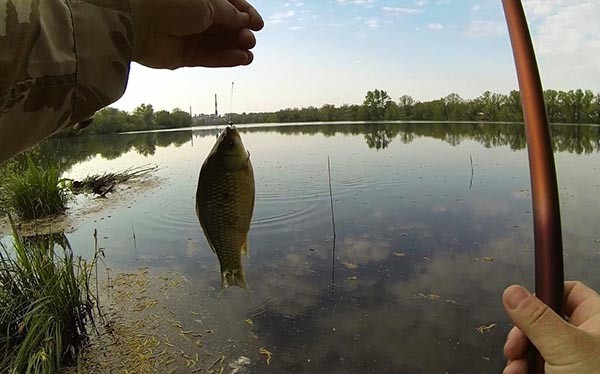
The main techniques when fishing with a float rod are casting, feeding, hooking, playing:
- Feeding - when fishing for crucian carp in spring on a float, bait is just as important as bait. The selected promising place is fed in early spring with a mixture of earth from molehills or dense coastal soil with crushed worms, small forage bloodworms. At the end of spring, most of the bait is made up of heavy cereals - millet, pearl barley, to which breadcrumbs, cake and a small amount of bait are added. They feed by making balls from the mixture and throwing them with your hand at the intended fishing point. Between the feeding and casting of the baited rig, at least 15-20 minutes should pass - during this time, the fish, disturbed by the fall of heavy balls into the water and attracted by the bait, will gather at the intended point.
- Cast - the equipment should be thrown in a smooth pendulum manner. When hitting the planned fishing spot, the rig should create as little noise as possible.
- Jogging - bites of crucian carp in spring are more confident and noticeable. The float may, after several smooth up and down movements, begin to abruptly move to the side, emerging to lie flat on the water. Often the bite of the crucian carp is very similar to the perch's - the float, without warning movements, sharply goes under the water. For all float movements described above, make a sharp and short strike.
- Rescue - carp should be fished out quickly, but carefully. The main thing in the process of playing is to prevent the fish from entangling the line by the snag, grass, flooded bushes. Large and medium-sized crucians are removed from the water using a landing net.
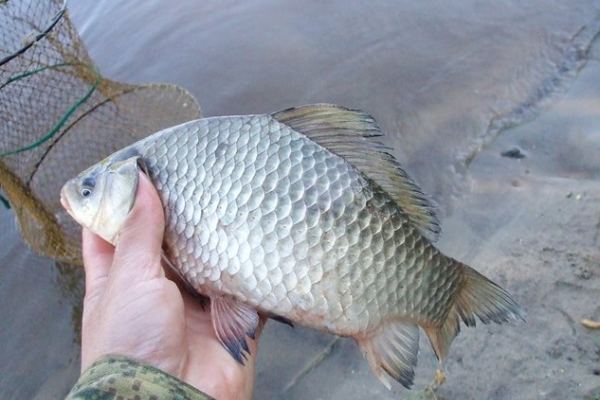
The specifics of fishing for crucian carp from the shore, boats and at night on a float
In spring, crucian carp is caught both from the shore and from the boat. Each type of fishing has its own characteristics.
Coastal
Fishing for crucian carp in spring from the shore on a float is the most widespread and popular type of fishing. Unlike fishing from a watercraft, onshore fishing has such features as:
- Long rods - when fishing from the shore, fishing rods up to 7-8 meters long are used.
- Thin rigs - in the spring, the thinnest and most durable fishing lines, small floats with a low load are suitable in clear water.
- Using two or more gear - coastal fishing allows you to use a large number of gear. The main thing when choosing fishing rods is to remember the legality of their use at a given time of the year - it is better to see in advance how many tackles and hooks are allowed by the rules of amateur fishing in a given period.
Video: fishing for crucian carp in the spring with a float rod from the shore
From the boat
Fishing for crucian carp from a boat is not so popular compared to coastal fishing. This type of fishing has the following characteristic features in comparison with the previous one:
- Short rods - when fishing for crucian carp from a boat, short side or telescopic rods with a length of no more than 3 meters are used.
- Coarser rigs - bites of large individuals often occur, for which you need a thicker and more durable rig.
- The depth is greater than the coastal - when fishing from a boat, the depth should be at least 2.0 meters, since at this time of the year the crucian carp at a shallow depth is very scared of the silhouette of a boat moving directly above it.
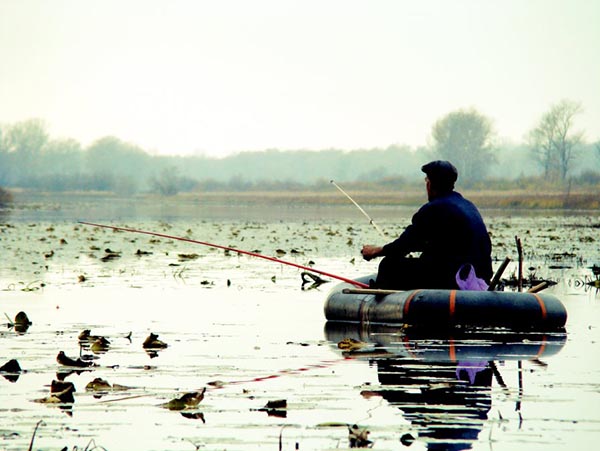
Fishing for crucian carp from a boat in spring is relevant in May, when, due to excessive heating of the water, the fish gradually moves away from the coastal shallow waters to remote deep-water areas.
Night fishing
Fishing for crucian carp at night on a float rod is practiced in warm spring. The best time for such fishing is the second half of May. Unlike day fishing, night fishing has a number of features:
- Successful night fishing requires that night was enough warm, without heavy rain, wind and thunderstorms.
- Pre-feeding - at night crucian carp are even more fearful and cautious, therefore they feed them several hours before the start of fishing, so that by the time it starts, the fish has already calmed down after splashes of bait falling into the water and approached it.
- Site preparation - in order not to bump into things and objects lying on the shore in the dark, even in the daytime the fishing site is cleaned of all unnecessary, the necessary equipment and tackle are placed nearby, firewood is prepared for a fire for the whole night.
- Short fly rods - since at night the crucian carp more boldly goes to the coastal shoals, more comfortable and lightweight short fly rods are used.
- Using a flashlight and luminous attachments - for fishing in the dark, it is imperative to use firefly attachments for floats and a powerful LED flashlight.
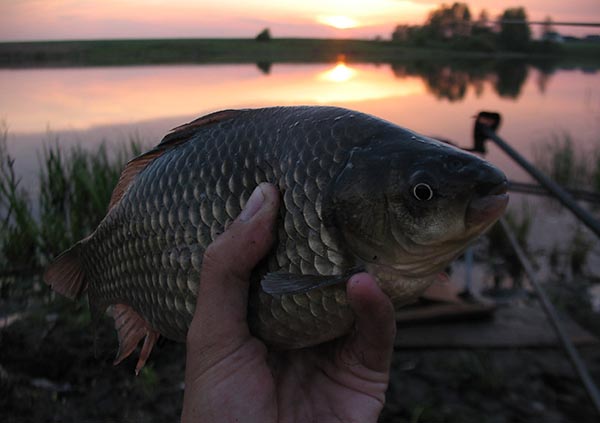
When fishing on a float in spring, it is also worth remembering that crucian carp does not belong to weedy species of fish, therefore, having caught a small carp, it should be released to grow back into the reservoir. This is not just a humane but also a rational attitude to fishing - from a small crucian in the future, a large and strong fish can grow, the capture of which will be true fishing happiness.

